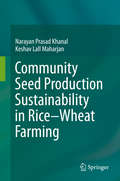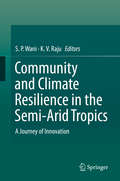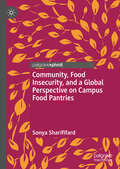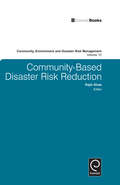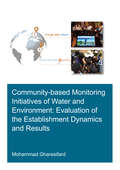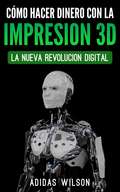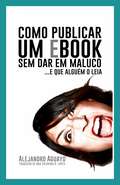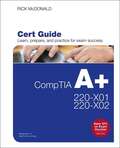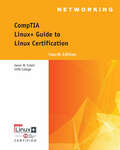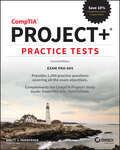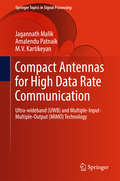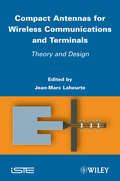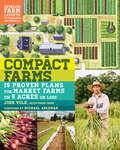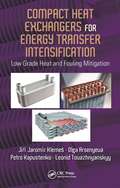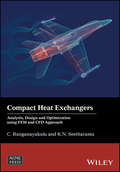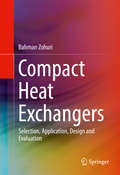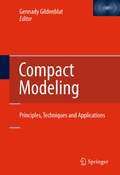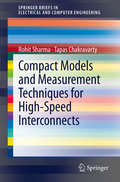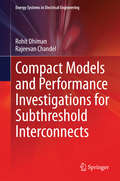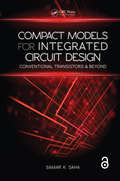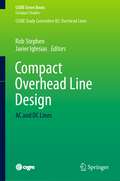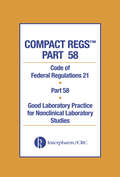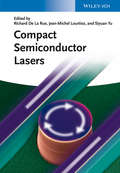- Table View
- List View
Community Seed Production Sustainability in Rice-Wheat Farming
by Narayan Prasad Khanal Keshav Lall MaharjanThis book analyzes the sustainability of community seed production under a rice-wheat farming system from microeconomic perspectives, considering how seed producers benefit from community seed production and how those benefits continue into the future. Seed producers' performance in resource management, governance and marketing strategies indicates current benefits, whereas soil conservation and risk-management practices provide the basis for future benefits. Community seed production is a local-level seed management system owned by farmers. This system provides the institutional mechanism to supply diversified seed demands of open-pollinated varieties of food crops in a cost-effective way in rural regions. Being able to address the concerns of food insecurity, poverty, climate stress and biodiversity loss in programs and policies of development agencies, community seed production is gaining popularity among the farmers and the policy makers in developing countries. This book discusses the issues of organizational governance of the community seed producers' groups and links them with household-level benefits to understand the organizational dynamism and the probable development paths of such organizations in the future. It also highlights the necessity to institutionalize lessons learned in community seed production in the stakeholders' programs and policies. These understandings provide a basis for formulating policies for strengthening the system in developing countries. Students, researchers, policy makers and donor agencies working with CSP in the developing world will find this book useful in broadening their understanding of CSP in general and its sustainability in particular.
Community and Climate Resilience in the Semi-Arid Tropics: A Journey of Innovation
by K. V. Raju S. P. WaniThis book focuses on developing an integrated holistic approach for harnessing the potential of rain-fed agriculture. In this approach, rainwater management through harvesting and recharging the groundwater is used as an entry point activity for increasing the productivity for farmers through enhanced water use efficiency. To provide the holistic and integrated solutions, the approach of consortium through building partnerships with different stakeholders, eg. different research institutions (State, National and International), development departments, eg. Department of Agriculture, Department of Animal Husbandry etc., Non-Government Organizations (NGOs), Farmers Organizations Community-based Organizations (CBOs) along with market linkages through private companies.
Community, Food Insecurity, and a Global Perspective on Campus Food Pantries
by Sonya SharififardThis book explores food accessibility and its relationship to food security in communities representing high populations of college and university students. Each chapter offers readers a vivid and multifaceted perspective on food practices' cultural and social complexities and the current food system. Using insights from the multidisciplinary fields of food studies, educational leadership, and human geography, this book engages the global paradoxes of food. Food is individual and community-based, and students participating in school activities and extracurriculars must often choose between affording books or food. Each chapter begins with a case study and ends with suggested resources and activities. Chapter topics include academic success, identity and belonging, groceries, food media, public health, marketing, surplus and scarcity, and social impact. The book further blends concepts and empirical accounts to address the central issues of culture, structure, and accessibility within and among the food retail environment.
Community-Based Disaster Risk Reduction
by Rajib ShawCommunities are at the core of disaster risk reduction (DRR), and community based approaches are getting increasing focus in national DRR plans. In the case of past disasters, communities were always the first responders and took leading roles in the post disaster recovery. The roles of communities in pre-disaster preparedness are also very important. This is the first comprehensive book available on CBDRR (community based disaster risk reduction) which outlines both research and practice, citing field examples and research results. It provides an overview of the subject and looks at the role of governments, NGOs, academics and corporate sectors in community based disaster risk reduction. It proceeds to examine experiences from Asian and African countries, and concludes by looking ahead to the future perspective of CBDRR.
Community-Based Monitoring Initiatives of Water and Environment: Evaluation of Establishment Dynamics and Results (IHE Delft PhD Thesis Series)
by Mohammad GharesifardCitizen participation in water and environmental management via community-based monitoring (CBM) has been praised for the potential to facilitate better informed, more inclusive, transparent, and representative decision making. However, methodological and empirical research trying to conceptualize and evaluate the dynamics at play that might enable or hinder these initiatives from delivering on their potential is limited. This research contributed to the conceptualization of CBMs through development of a conceptual framework that is suitable for Context analysis, Process evaluation and Impact assessment of CBMs – the CPI Framework. This conceptualization provides an interpretation of what 'community' means in the context of a CBM initiative. In addition, this research contributed to the existing empirical knowledge about the establishment, functioning and outcomes of CBMs by testing the CPI Framework for studying two real life CBMs throughout the lifetime of an EU-funded project - the Ground Truth 2.0. The first CBM is called Grip op Water Altena that focuses on the issue of pluvial floods in 'Land van Heusden en Altena' of the Netherlands. The second CBM is Maasai Mara Citizen Observatory and aims at contributing to a better balance between biodiversity conservation and sustainable livelihood management in the Mara ecosystem in Kenya.
Como Hacer Dinero Con La Impresion 3D: La Nueva Revolucion Digital
by Adidas WilsonDESCRIPCIÓN A medida que se populariza la impresión 3D, muchos han aprovechado esta industria para labrarse una fortuna y ganar en grande. Estos resultados no son ciertamente pan comido, pero por otra parte la única manera de tener éxito es salir a buscarlo, y revisar qué han hecho quienes han logrado conceptualizar esta forma de hacer dinero. Si ha estado siempre interesado en la impresión 3D y quiere hacer dinero con esta tecnología, es hora de que piense inteligentemente y venza cualquier obstáculo que se presente. Los modelos que quiera imprimir en 3D puede crearlos con un paquete CAD (diseño asistido por computador), con un escáner 3D, o con una simple cámara digital y un software de fotogrametría. Los modelos con CAD resultan con menos errores y pueden corregirse antes, pues permiten la verificación del diseño del objeto antes de imprimirlo. Hay varios proyectos y empresas esforzándose por desarrollar impresoras 3D accesibles para su uso personal en su casa. Gran parte de este trabajo ha sido movido y orientado por comunidades hágalo-usted-mismo, aficionados a hacer cosas, innovadores, con lazos adicionales al mundo académico y miembros de comunidades de hackers. La impresión tridimensional hace que sea igual de barato imprimir una pieza que miles y por esto le quita el atractivo a la economía de escala. Puede llegar a tener un impacto tan grande a nivel mundial como lo tuvo en su momento la revolución industrial y el surgimiento de las fábricas… Así como nadie podía prever en 1750 el impacto que tendría la máquina de vapor, en 1450 el que tendría la imprenta, o en 1950 lo que sería el impacto del transistor, en este momento no es posible predecir el impacto a largo plazo de la impresión 3D. Pero la tecnología está llegando, y es probable que revolucione cada uno de los campos que toque. — Tomado de “The Economist” edición líder de Febrero 10, 2011
Como Publicar Um Ebook Sem Dar Em Maluco. E Que Alguém O Leia
by Alejandro Aguayo Catarina LopesGuia prático, passo a passo, sobre como publicar um livro electrónico, sem dramas e sem os erros típicos de principiante. Oferece truques, recursos, programas e, principalmente, a experiência de muitos autores indie que triunfam hoje em dia com os seus eBooks, como Blanca Miosi, Bruno Nievas, Enrique Laso, Gabri Ródenas, Lidia Herbada, Roberto López-Herrero, Largo Javariega, entre outros.
Como usar a Apple TV 4K: Um guia de uso para a Apple TV com o Controle Remoto Siri
by Adidas WilsonQuando se ouve falar em Apple TV, as pessoas pensam automaticamente que estão comprando um aparelho de televisão. Mas não é isso. A Apple TV é, na verdade, um aparelho usado para streaming, parecido com o Fire, da Amazon ou com o Roku. É uma caixinha preta de quase quatro centímetros de altura, e quase dez centímetros de largura, e usa uma plataforma similar à do iPad e iPhone. É possível fazer o download de uma lista de aplicativos e jogos, algo que vai além das plataformas comuns de streaming como Hulu, Netflix e Amazon, por exemplo. A Apple TV é centrada em vários aplicativos, e ainda é capaz de transmitir vários seriados e filmes diretamente na sua HDTV, mas essa é só a ponta do iceberg de todos os usos que essa caixinha disponibiliza. Com essa caixa você pode assistir e ouvir podcasts, jogar seus jogos favoritos, ouvir a sua playlist de academia, e muito mais. Mas é importante mencionar que para aproveitar todos os benefícios que esta caixa está pronta para proporcionar, é preciso instalar os aplicativos. Alguns dos aplicativos são gratuitos, outros são pagos. Pense dessa forma; a Apple TV pode transformar a sua televisão em uma TV Smart. Você pode alugar seus filmes favoritos ou assistir à coleção da sua conta do iTunes. Você também pode assistir filmes e seriados nos aplicativos como Netflix e Hulu Plus; e ouvir música dos aplicativos Pandora e Apple Music. A lista de coisas que a Apple TV pode fazer por você é interminável. A Apple TV 4K foi feita com alguns dos processadores mais rápidos que existem, os mesmos do iPad Pro. A caixa da Apple TV foi projetada para ser tão potente quanto a maioria dos laptops que usamos. Ela também tem processadores gráficos velozes que foram projetados para transformar a caixinha preta em um console de videogame. Nada parece ser melhor do que isso. A Apple realmente deu uma nova cara à nova geração, mas isso não significa que você deva jogar o seu modelo antigo fora, é a mesma cois
CompTIA A+ Core 1 (220-1001) and Core 2 (220-1002) Cert Guide (Certification Guide)
by Rick McDonald Richard McDonaldCompTIA A+ Cert Guide Core 1 (220-1001) and Core 2 (220-1002), 5th Edition is a best-of-breed exam study guide. Leading IT certification instructor Rick McDonald shares preparation hints and test-taking tips, helping you identify areas of weakness and improve both your conceptual knowledge and hands-on skills. Material is presented in a concise manner, focusing on increasing your understanding and retention of exam topics.
CompTIA Linux+ Guide to Linux Certification
by Jason W. Eckert triOS CollegeEquip today’s users with the most up-to-date information to pass CompTIA's Linux®+ (Powered by LPI) Certification exam successfully and excel when using Linux® in the business world with Eckert’s LINUX®+ GUIDE TO LINUX® CERTIFICATION, 4E. This complete guide provides a solid conceptual foundation and mastery of the hands-on skills necessary to work with the Linux® operation system in today’s network administration environment. The author does an exceptional job of maintaining a focus on quality and providing classroom usability while highlighting valuable real-world experiences. This edition’s comprehensive coverage emphasizes updated information on the latest Linux® distributions as well as storage technologies commonly used in server environments, such as LVM and ZFS. New, expanded material addresses key job-related networking services, including FTP, NFS, Samba, Apache, DNS, DHCP, NTP, Squid, Postfix, SSH, VNC, Postgresql, and iptables/firewalld. Readers study the latest information on current and emerging security practices and technologies. Hands-On Projects help learners practice new skills using both Fedora™ 20 and Ubuntu® Server 14.04 Linux®, while review questions and key terms reinforce important concepts. Numerous time-saving online resources are available to assist with lab and test preparation. Trust LINUX®+ GUIDE TO LINUX® CERTIFICATION, 4E for the mastery today’s users need for success on the certification exam and throughout their careers.
CompTIA Project+ Practice Tests: Exam PK0-005
by Brett J. FeddersenAn indispensable study aid for an in-demand project management certification In the newly updated second edition of CompTIA Project+ Practice Tests: Exam PK0-005, veteran tech educator and project manager Brett J. Feddersen delivers an indispensable study aid for anyone preparing for the CompTIA Project+ certification exam or a new career in project management. This new edition is fully revised to reflect recent changes to the Project+ PK0-005 exam, and offers new questions that emphasize the importance of agile and other iterative project management methodologies commonly used in IT environments. You&’ll explore every objective covered by the Project+ exam, including project management concepts, project life cycle phases, project tools and documentation, and the basics of information technology and governance. You&’ll also find: Hands-on and practical information you can use immediately to prepare for a new career in project management, or for expanding your existing skillset Hundreds of domain-by-domain questions that pinpoint exactly where you excel and where you need more training A true-to-life testing format that prepares you for the real-world exam and reduces test anxiety so you can focus on succeeding your first time taking the testA can&’t-miss resource for aspiring and veteran project managers, CompTIA Project+ Practice Tests: Exam PK0-005, Second Edition, belongs in the hands of anyone hoping to master the latest version of the Project+ exam or distinguish themselves on their first day of a new project management job.
CompTIA® A+ Core 1 (220-1001) and Core 2 (220-1002) Cert Guide
by Rick McDonaldLearn, prepare, and practice for CompTIA A+ Core 1 (220-1001) and Core 2 (220-1002) exam success with this CompTIA Cert Guide from Pearson IT Certification, a leader in IT Certification learning. Master CompTIA A+ Core 1 (220-1001) and Core 2 (220-1002) exam topics Assess your knowledge with chapter-ending quizzes Review key concepts with exam preparation tasks Practice with realistic exam questions Get practical guidance for next steps and more advanced certifications CompTIA A+ Cert Guide Core 1 (220-1001) and Core 2 (220-1002), 5th Edition is a best-of-breed exam study guide. Leading IT certification instructor Rick McDonald shares preparation hints and test-taking tips, helping you identify areas of weakness and improve both your conceptual knowledge and hands-on skills. Material is presented in a concise manner, focusing on increasing your understanding and retention of exam topics. The book presents you with an organized test preparation routine through the use of proven series elements and techniques. Exam topic lists make referencing easy. Chapter-ending Exam Preparation Tasks help you drill on key concepts you must know thoroughly. Review questions help you assess your knowledge, and a final preparation chapter guides you through tools and resources to help you craft your final study plan. The companion website contains the powerful Pearson Test Prep practice test software, complete with over 600 exam-realistic questions, including quiz, pre-assessment, and post-assessment questions. The assessment engine offers you a wealth of customization options and reporting features, laying out a complete assessment of your knowledge to help you focus your study where it is needed most. Digital Key Terms Flashcards are included for every term in the glossary and help you master each concept.
Compact Antennas for High Data Rate Communication: Ultra-wideband (UWB) and Multiple-Input-Multiple-Output (MIMO) Technology (Springer Topics in Signal Processing #14)
by Amalendu Patnaik M. V. Kartikeyan Jagannath MalikThis book discusses the development of promising technologies for compact antennas for high data-rate communications. It discusses and analyzes the design of compact ultra-wideband (UWB) and multiple input, multiple output (MIMO) antennas, providing essential know-how for designers, practicing engineers and scientists. These wireless communication technologies enable consumers to have convenient access to a wide range of services - anytime, anywhere. And the introduction of wireless mobile access points eliminates the limitations to communication imposed by geographical location. The Internet has allowed people to access and share information much more rapidly, but in order to achieve higher data rates with the limited available resources and imposed constraints, wireless communication technology needs to be pushed beyond the physical limits of the propagation channel. This book contributes to achieving this goal.
Compact Antennas for Wireless Communications and Terminals: Theory and Design (Wiley-iste Ser.)
by Jean-Marc LaheurteCompact Antennas for Wireless Communications and Terminals deals with compact microwave antennas and, more specifically, with the planar version of these antennas. Planar antennas are the most appropriate type of antenna in modern communication systems and more generally in all applications requiring miniaturization, integration and conformation such as in mobile phone handsets. The book is suitable for students, engineers and scientists eager to understand the principles of planar and small antennas, their design and fabrication issues, and modern aspects such as UWB antennas, reconfigurable antennas and diversity issues.
Compact Farms: 15 Proven Plans for Market Farms on 5 Acres or Less; Includes Detailed Farm Layouts for Productivity and Efficiency
by Josh VolkSmall is beautiful, and these 15 real farm plans show that small-scale farmers can have big-time success. Compact Farms is an illustrated guide for anyone dreaming of starting, expanding, or perfecting a profitable farming enterprise on five acres or less. The farm plans explain how to harness an area&’s water supply, orientation, and geography in order to maximize efficiency and productivity while minimizing effort. Profiles of well-known farmers such as Eliot Coleman and Jean-Martin Fortier show that farming on a small scale in any region, in both urban and rural settings, can provide enough income to turn the endeavor from hobby to career. These real-life plans and down-and-dirty advice will equip you with everything you need to actually realize your farm dreams.
Compact Heat Exchangers for Energy Transfer Intensification: Low Grade Heat and Fouling Mitigation
by Olga Arsenyeva Jiri Jaromir Klemes Petro Kapustenko Leonid TovazhnyanskyyCompact Heat Exchangers for Energy Transfer Intensification: Low-Grade Heat and Fouling Mitigation provides theoretical and experimental background on heat transfer intensification in modern heat exchangers. Emphasizing applications in complex heat recovery systems for the process industries, this book:Covers various issues related to low-grade hea
Compact Heat Exchangers: Analysis, Design and Optimization using FEM and CFD Approach
by Kankanhalli N. Seetharamu C. RanganayakuluA comprehensive source of generalized design data for most widely used fin surfaces in CHEs Compact Heat Exchanger Analysis, Design and Optimization: FEM and CFD Approach brings new concepts of design data generation numerically (which is more cost effective than generic design data) and can be used by design and practicing engineers more effectively. The numerical methods/techniques are introduced for estimation of performance deteriorations like flow non-uniformity, temperature non-uniformity, and longitudinal heat conduction effects using FEM in CHE unit level and Colburn j factors and Fanning friction f factors data generation method for various types of CHE fins using CFD. In addition, worked examples for single and two-phase flow CHEs are provided and the complete qualification tests are given for CHEs use in aerospace applications. Chapters cover: Basic Heat Transfer; Compact Heat Exchangers; Fundamentals of Finite Element and Finite Volume Methods; Finite Element Analysis of Compact Heat Exchangers; Generation of Design Data by CFD Analysis; Thermal and Mechanical Design of Compact Heat Exchanger; and Manufacturing and Qualification Testing of Compact Heat Exchanger. Provides complete information about basic design of Compact Heat Exchangers Design and data generation is based on numerical techniques such as FEM and CFD methods rather than experimental or analytical ones Intricate design aspects included, covering complete cycle of design, manufacturing, and qualification of a Compact Heat Exchanger Appendices on basic essential fluid properties, metal characteristics, and derivation of Fourier series mathematical equation Compact Heat Exchanger Analysis, Design and Optimization: FEM and CFD Approach is ideal for senior undergraduate and graduate students studying equipment design and heat exchanger design.
Compact Heat Exchangers: Selection, Application, Design and Evaluation
by Bahman ZohuriThis book describes the fundamentals and applications of compact heat exchangers in energy generation. Thetext focuses on their efficiency impacts on power systems, particularly emphasizing alternative energy sources such as Concentrated Solar Power and nuclear plants. The various types of compact heat exchanger surfaces anddesigns are given thorough consideration before the author turns his attentionto describing how these compact heat exchangers can be applied to innovative plant designs, and how to conduct operational and safety analyses to optimize thermal efficiency. The book iswritten at an undergraduate level, but will be useful to practicing engineersand scientists as well.
Compact Modeling: Principles, Techniques and Applications
by Gennady GildenblatMost of the recent texts on compact modeling are limited to a particular class of semiconductor devices and do not provide comprehensive coverage of the field. Having a single comprehensive reference for the compact models of most commonly used semiconductor devices (both active and passive) represents a significant advantage for the reader. Indeed, several kinds of semiconductor devices are routinely encountered in a single IC design or in a single modeling support group. Compact Modeling includes mostly the material that after several years of IC design applications has been found both theoretically sound and practically significant. Assigning the individual chapters to the groups responsible for the definitive work on the subject assures the highest possible degree of expertise on each of the covered models.
Compact Models and Measurement Techniques for High-Speed Interconnects (SpringerBriefs in Electrical and Computer Engineering)
by Rohit Sharma Tapas ChakravartyCompact Models and Measurement Techniques for High-Speed Interconnects provides detailed analysis of issues related to high-speed interconnects from the perspective of modeling approaches and measurement techniques. Particular focus is laid on the unified approach (variational method combined with the transverse transmission line technique) to develop efficient compact models for planar interconnects. This book will give a qualitative summary of the various reported modeling techniques and approaches and will help researchers and graduate students with deeper insights into interconnect models in particular and interconnect in general. Time domain and frequency domain measurement techniques and simulation methodology are also explained in this book.
Compact Models and Performance Investigations for Subthreshold Interconnects (Energy Systems in Electrical Engineering)
by Rohit Dhiman Rajeevan ChandelThe book provides a detailed analysis of issues related to sub-threshold interconnect performance from the perspective of analytical approach and design techniques. Particular emphasis is laid on the performance analysis of coupling noise and variability issues in sub-threshold domain to develop efficient compact models. The proposed analytical approach gives physical insight of the parameters affecting the transient behavior of coupled interconnects. Remedial design techniques are also suggested to mitigate the effect of coupling noise. The effects of wire width, spacing between the wires, wire length are thoroughly investigated. In addition, the effect of parameters like driver strength on peak coupling noise has also been analyzed. Process, voltage and temperature variations are prominent factors affecting sub-threshold design and have also been investigated. The process variability analysis has been carried out using parametric analysis, process corner analysis and Monte Carlo technique. The book also provides a qualitative summary of the work reported in the literature by various researchers in the design of digital sub-threshold circuits. This book should be of interest for researchers and graduate students with deeper insights into sub-threshold interconnect models in particular. In this sense, this book will best fit as a text book and/or a reference book for students who are initiated in the area of research and advanced courses in nanotechnology, interconnect design and modeling.
Compact Models for Integrated Circuit Design: Conventional Transistors and Beyond
by Samar K. SahaCompact Models for Integrated Circuit Design: Conventional Transistors and Beyond provides a modern treatise on compact models for circuit computer-aided design (CAD). Written by an author with more than 25 years of industry experience in semiconductor processes, devices, and circuit CAD, and more than 10 years of academic experience in teaching compact modeling courses, this first-of-its-kind book on compact SPICE models for very-large-scale-integrated (VLSI) chip design offers a balanced presentation of compact modeling crucial for addressing current modeling challenges and understanding new models for emerging devices. Starting from basic semiconductor physics and covering state-of-the-art device regimes from conventional micron to nanometer, this text: Presents industry standard models for bipolar-junction transistors (BJTs), metal-oxide-semiconductor (MOS) field-effect-transistors (FETs), FinFETs, and tunnel field-effect transistors (TFETs), along with statistical MOS models Discusses the major issue of process variability, which severely impacts device and circuit performance in advanced technologies and requires statistical compact models Promotes further research of the evolution and development of compact models for VLSI circuit design and analysis Supplies fundamental and practical knowledge necessary for efficient integrated circuit (IC) design using nanoscale devices Includes exercise problems at the end of each chapter and extensive references at the end of the book Compact Models for Integrated Circuit Design: Conventional Transistors and Beyond is intended for senior undergraduate and graduate courses in electrical and electronics engineering as well as for researchers and practitioners working in the area of electron devices. However, even those unfamiliar with semiconductor physics gain a solid grasp of compact modeling concepts from this book.
Compact Overhead Line Design: AC and DC Lines (CIGRE Green Books)
by Rob Stephen Javier IglesiasThis Green Book provides the design engineer with an understanding of the electrical parameters and methods required in designing compact AC and DC lines. Compact AC and DC lines are becoming increasingly necessary due to the limitation of right of way access and the need to upgrade power transfer in existing, narrower line corridors. Another requirement for compact AC lines is the lower impedance permitting increased power flow.For DC power lines, increased power flow can only be realised by increasing the current through the conductors and/or increasing line voltage. In AC it can also be achieved by bundle expansion and phase compaction due to the variation of impedance. The effect of compaction on AC and DC lines is not identical as with the constraints. The Green Book covers the theory relating to the constraints such as corona, audible noise, insulation coordination, electric and magnetic fields and others for both AC and DC lines.In addition to the theory, the Green Book includes actual calculations of electric parameters for different pole (DC) and phase (AC) configurations. Standards applied by various countries are tabulated for easy comparison of practices internationally. Case studies on line compaction designs for both AC and DC are described with relation to pole compaction, pole rearrangement and phase configuration. Voltage upgrading is also treated in this book, and some case studies for both AC and DC are considered.
Compact Regs Part 58: CFR 21 Part 58 Good Laboratory Practice for Non-clinical Laboratory Studies 10 Pack, Second Edition
by Interpharm CrcThis publication contains a verbatim reproduction of 21 CFR Part 58 Good Laboratory Practice for Nonclinical Laboratory Studies.
Compact Semiconductor Lasers
by Siyuan Yu Jean-Michel Lourtioz Richard De La RueThis book brings together in a single volume a unique contribution by the top experts around the world in the field of compact semiconductor lasers to provide a comprehensive description and analysis of the current status as well as future directions in the field of micro- and nano-scale semiconductor lasers. It is organized according to the various forms of micro- or nano-laser cavity configurations with each chapter discussing key technical issues, including semiconductor carrier recombination processes and optical gain dynamics, photonic confinement behavior and output coupling mechanisms, carrier transport considerations relevant to the injection process, and emission mode control.Required reading for those working in and researching the area of semiconductors lasers and micro-electronics.
